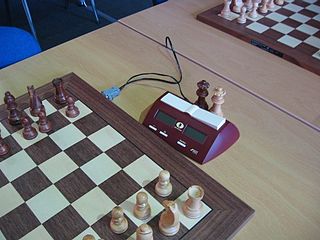
Backgammon is one of the oldest known board games. Its history can be traced back nearly 5,000 years to archeological discoveries in the Middle East, originally in Iran. It is a two player game where each player has fifteen pieces (checkers) which move between twenty-four triangles (points) according to the roll of two dice. The objective of the game is to be first to bear off, i.e. move all fifteen checkers off the board. Backgammon is a member of the tables family, one of the oldest classes of board games.

Gomoku, also called Five in a Row, is an abstract strategy board game. It is traditionally played with Go pieces on a Go board, using 15×15 of the 19×19 grid intersections. Because pieces are not moved or removed from the board, Gomoku may also be played as a paper-and-pencil game. The game is known in several countries under different names.

Pente is a strategy board game for two or more players, created in 1977 by Gary Gabrel, a dishwasher at Hideaway Pizza, in Stillwater, Oklahoma. Customers played Pente at Hideaway Pizza on checkerboard tablecloths while waiting for their orders to arrive. Thirty years later, patrons are still playing Pente at Hideaway Pizza, although now with roll-up Pente boards. Pente is based on the Japanese game ninuki-renju, a variant of renju or gomoku that is played on a Go board of 19x19 intersections with white and black stones. Like ninuki-renju, Pente allows captures, but Pente added a new opening rule. In the nineteenth century, gomoku was introduced to Britain where it was known as "Go Bang."

Shogi, also known as Japanese chess or the Game of Generals, is a two-player strategy board game native to Japan in the same family as chess, makruk, shatranj, janggi and xiangqi, and is the most popular chess variant in Japan. Shōgi means general's board game.

Chess960, also known as Fischer Random Chess or Fischerandom, is a variant of chess invented and advocated by former world chess champion Bobby Fischer, announced publicly on June 19, 1996, in Buenos Aires, Argentina. It employs the same board and pieces as standard chess, but the starting position of the pieces on the players' home ranks is randomized. The random setup renders the prospect of obtaining an advantage through the memorization of opening lines impracticable, compelling players to rely instead on their talent and creativity.
This page explains commonly used terms in chess in alphabetical order. Some of these have their own pages, like fork and pin. For a list of unorthodox chess pieces, see Fairy chess piece; for a list of terms specific to chess problems, see Glossary of chess problems; for a list of chess-related games, see List of chess variants.

TwixT is a two-player strategy board game, an early entrant in the 1960s 3M bookshelf game series. It became one of the most popular and enduring games in the series. It is a connection game where players alternate turns placing pegs and links on a pegboard in an attempt to link their opposite sides. The rules are simple but the strategy complex, so young children can play it, but it also appeals to adults. The game has been discontinued except in Germany.

Promotion is a chess rule that requires a pawn that reaches its eighth rank to be immediately replaced by the player's choice of a queen, knight, rook, or bishop of the same color. The new piece replaces the pawn, as part of the same move. The choice of new piece is not limited to pieces previously captured, thus promotion can result in a player owning, for example, two or more queens despite starting the game with one. Pawn promotion, or the threat of it, often decides the result in an endgame. Since the queen is the most powerful piece, the vast majority of promotions are to a queen. Promotion to a queen is often called queening; promotion to any other piece is referred to as underpromotion.

English draughts or checkers, also called American checkers or straight checkers, is a form of the strategy board game draughts. It is played on an 8×8 chequered board with 12 pieces per side. The pieces move and capture diagonally forward, until they reach the opposite end of the board, when they are crowned and can thereafter move and capture both backward and forward.

Connect6 introduced in 2003 by Professor I-Chen Wu at Department of Computer Science and Information Engineering, National Chiao Tung University, is a two-player strategy game similar to Gomoku.

Lines of Action is a strategy board game for two players invented by Claude Soucie. The objective is to connect all of one's pieces into a single group.

The following outline is provided as an overview of and topical guide to chess:
Taraguchi opening rule is a renju opening rule. It was proposed by Yusui Yamaguchi as an advancement of a Tarannikov opening rule and therefore it was named with a combination of these two names. It has an enhancement, Taraguchi-N opening rule.
Soosõrv opening rule is a renju opening rule. It was developed by Estonian player Ants Soosõrv.
Swap opening rule is a renju opening rule. It was adopted by RIF in the late 80s and was an official rule for Renju World Championships from 1989 till 1995.
Gomocup is a worldwide tournament of artificial intelligences (AI) playing Gomoku and Renju. The tournament has been played since 2000 and takes place every year. As of 2016, it is the most famous and largest Gomoku AI tournament in the world, with around 40 participants from about 10 countries.
There are several world championships in Renju organized by the Renju International Federation, including World Championship, Women World Championships, Team World Championships, Youth World Championships and Correspondence World Championships.










